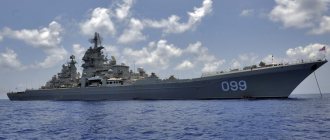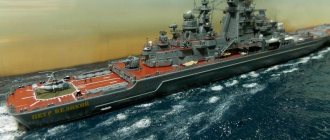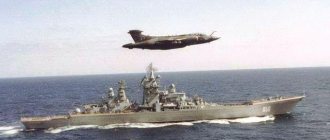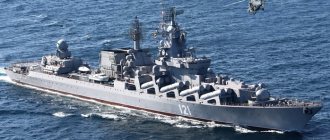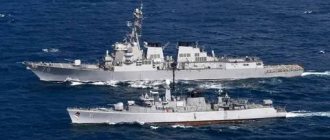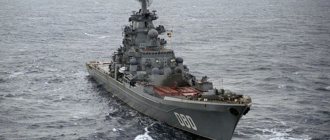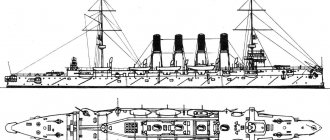Cruisers | USA
Battlecruiser "Alaska" (SV-1)
The series of large cruisers of the "Alaska" type consisted of 2 units ("Alaska", "Guam") and was commissioned in 1944. The cruiser "Alaska" was decommissioned in 1960, and "Guam" - in 1958. Performance characteristics of the ship : standard displacement – 29.8 thousand tons; full – 34.3 thousand tons; length – 241 m; width – 27.8 m; draft - 9.7 m; speed - 33 knots; power plants - 4 steam plants and 8 steam boilers; power – 150 thousand hp; fuel reserve - 3.6 thousand tons. oil; cruising range - 12 thousand miles; crew – 1,500 people. Reservation: belt – 227 – 127 mm; upper deck – 36 mm; main deck – 102 – 96 mm; towers - 325 mm; barbettes – 330 – 280 mm; deckhouse – 269 mm. Armament: 3x3 - 305 mm guns; 6x2 - 127 mm guns, 14x4 - 40 mm anti-aircraft guns, 4x1 - 20 mm anti-aircraft guns, 2 catapults and 3 seaplanes.
Heavy cruiser heavy cruisers “Pensacola” (S-24)
Heavy cruiser heavy cruisers “Salt Lake City” (S-25)
The series of heavy cruisers of the Pensacola class consisted of 2 units (Pensacola, Salt Lake City) and were commissioned in 1930 and 1929. respectively. Both ships were sunk in 1948 while testing new weapons. Performance characteristics of the ship: standard displacement - 9.1 thousand tons; full – 12.1 thousand tons; length – 174 m; width – 20 m; draft - 5.9 m; speed – 32.5 knots; power plants - 4 steam plants and 8 steam boilers; power – 107 thousand hp; fuel reserve - 3 thousand tons. oil; cruising range - 10 thousand miles; crew - 630 people. Reservation: belt – 65 – 102 mm; deck – 25 mm; cellars – 102 mm; towers - 65 mm; barbettes – 19 mm; cutting – 32 mm. Armament: 2x3 and 2x2 - 203 mm guns; 8x1 - 127 mm guns, 2x4 - 28 mm anti-aircraft guns, 2 catapults and 4 seaplanes.
Heavy cruiser Northampton (CA-26)
Heavy cruiser Chicago (CA-29)
Heavy cruiser Houston (CA-30)
Heavy cruiser Augusta (SA-31)
The series of heavy cruisers of the "Northampton" type consisted of 6 units ("Northampton", "Chester", "Louisville", "Chicago", "Augusta", "Houston") and were commissioned in 1930-1931. During the period of service on the ships, anti-aircraft weapons were strengthened. The cruisers Northampton and Houston were lost in 1942, and Chicago in 1943. The rest were decommissioned in 1959. Performance characteristics of the ship: standard displacement - 9 - 9.3 thousand tons; full - 11.4 - 12.4 thousand tons; length – 177 m; width – 20 m; draft - 5.9 m; speed – 32.5 knots; power plants - 4 steam plants and 8 steam boilers; power – 107 thousand hp; fuel reserve – 1.4 – 2.1 thousand tons. oil; cruising range - 10 thousand miles; crew – 620 people. Armor: belt – 76 mm; deck – 25 mm; cellars – 95 mm; towers - 65 mm; barbettes – 37 mm; cutting – 32 mm. Armament: 3x3 - 203 mm guns; 8x1 - 127 mm guns, 4x4 - 28 mm anti-aircraft guns, 8 - 12.7 mm machine guns, 2 catapults and 4 seaplanes.
Heavy cruiser "Portland" (CA-33)
Heavy cruiser Indianapolis (CA-35)
The series of heavy cruisers of the "Portland" type consisted of 2 units ("Portland", "Indianapolis") and were commissioned in 1933 and 1932. respectively. In 1943, both ships underwent modernization. The cruiser Indianapolis was lost in 1945, and Portland was decommissioned in 1959. Performance characteristics of the ship: standard displacement - 10.3 thousand tons; full – 12.8 thousand tons; length – 180 m; width – 20 m; draft – 6.4 m; speed – 32.5 knots; power plants - 4 steam plants and 8 steam boilers; power – 107 thousand hp; fuel reserve – 1.4 – 2.1 thousand tons. oil; cruising range - 10 thousand miles; crew - 850 people. Armor: belt – 57 mm; deck –65 mm; cellars – 146 mm; towers - 65 mm; barbettes – 37 mm; cutting – 32 mm. Armament: 3x3 - 203 mm guns; 8x1 - 127 mm guns, 8 - 12.7 mm machine guns, 2 catapults and 4 seaplanes.
Heavy cruiser New Orleans (CA-32)
Heavy cruiser "Astoria" (SA-34)
Heavy cruiser Tuscaloosa (CA-37)
Heavy cruiser "San Francisco" (CA-38)
The series of heavy cruisers of the "New Orleans" class consisted of 7 units ("New Orleans", "Astoria", "Minneapolis", "Tuscaloosa", "San Francisco", "Quicy", "Vincennes") and was commissioned in 1934- 1937 In 1939-1942 The ships' anti-aircraft artillery was updated. The cruisers “Astoria”, “Quicy” and “Vincennes” were lost in 1942, the rest were decommissioned in 1959. Performance characteristics of the ship: standard displacement - 9.3 - 10.1 thousand tons; full – 12.5 thousand tons; length – 177 m; width – 19 m; draft - 6.9 m; speed - 32.7 knots; power plants - 4 steam plants and 8 steam boilers; power – 107 thousand hp; fuel reserve – 2.4 – 2.3 thousand tons. oil; cruising range - 10 thousand miles; crew - 700 - 750 people. Reservation: belt – 82 – 127 mm; deck – 57 – 30 mm; cellars – 76 – 102 mm; towers – 203 – 70 mm; barbettes – 127 mm; deckhouse – 127 mm. Armament: 3x3 - 203 mm guns; 8x1 - 127 mm guns, 8 - 12.7 mm machine guns, 2 catapults and 4 seaplanes.
Heavy cruiser "Wichita" (CA-45)
The cruiser was built at the Philadelphia Naval Shipyard and put into operation in 1939. In 1941 - 1943. The cruiser's anti-aircraft weapons were updated. The ship was scrapped in 1959. Performance characteristics of the ship: standard displacement - 10.6 thousand tons; full – 13 thousand tons; length – 183 m; width – 19 m; draft – 7.2 m; speed - 33 knots; power plants - 4 steam plants and 8 steam boilers; power – 100 thousand hp; fuel reserve – 2 thousand tons. oil; cruising range - 10 thousand miles; crew - 930 people. Reservation: belt – 102 – 152 mm; deck – 57 mm; towers – 203 – 70 mm; barbettes – 178 mm; deckhouse – 152 mm. Armament: 3x3 - 203 mm guns; 8x1 - 127 mm guns, 2x4 - 28 mm anti-aircraft guns, 8x1 - 12.7 mm machine guns, 2 catapults and 4 seaplanes.
Heavy cruiser "Baltimore" (CA-68)
Heavy cruiser Pittsburgh (CA-72)
Heavy cruiser Boston (CA-69)
Heavy cruiser Los Angeles (CA-135)
The Baltimore-class series of heavy cruisers consisted of 12 units (Baltimore, Boston, Canberra, Quincy, Pittsburgh, St. Paul, Columbus, Helena, Bremerton, "Fall River", "Macon", "Toledo", "Los Angeles", "Chicago") and was commissioned 1943-1945. The ships were decommissioned in 1969-1978. Performance characteristics of the ship: standard displacement - 14.4 thousand tons; full – 17 thousand tons; length – 202 m; width – 21.6 m; draft – 7.3 m; speed - 34 knots; power plants - 4 steam plants and 4 steam boilers; power – 120 thousand hp; fuel reserve – 2.7 thousand tons. oil; cruising range - 10 thousand miles; crew – 1,140 people. Reservation: belt – 102 – 152 mm; deck – 65 mm; towers – 203 – 95 mm; barbettes – 160 mm; deckhouse – 152 mm. Armament: 3x3 - 203 mm guns; 6x2 – 127 mm guns; 12x4 - 40 mm anti-aircraft guns, 24 - 28 - 20 mm anti-aircraft guns, 2 catapults, 2 or 4 seaplanes.
Light cruiser Omaha (CL-4)
Light cruiser Raleigh (CL-7)
Light cruiser "Cincinnati" (CL-6)
Light cruiser Trenton (CL-11)
Light cruiser Richmond (CL-9)
The Omaha-class light cruiser series consisted of 10 units (Omaha, Milwaukee, Cincinnati, Raleigh, Detroit, Richmond, Concord, Trenton, Marblehead, Memphis ") and was commissioned in 1923-1925. Before the war, the conning towers were removed from the ships and the bridges were rebuilt. In 1942-1944. anti-aircraft weapons were updated. The ships were decommissioned in 1944-1947. Performance characteristics of the ship: standard displacement - 7.3 thousand tons; full – 9.2 thousand tons; length – 167 m; width – 17 m; draft – 4.1 m; speed - 34 knots; power plants - 4 steam plants and 12 steam boilers; power – 90 thousand hp; fuel reserve – 1.9 thousand tons. oil; cruising range - 8.5 thousand miles; crew - 460 people. Armor: belt – 76 mm, deck – 37 mm, deckhouse – 32 mm. Armament: 2x2 and 8x1 - 152 mm guns; 8x1 – 76 mm guns, 8x1 – 12.7 mm machine guns, 2x3 – 533 mm torpedo tubes, 2 catapults and 2 seaplanes.
Light cruiser Brooklyn (CL-40)
Light cruiser Philadelphia (CL-41)
Light cruiser Nashville (CL-43)
Light cruiser Boise (CL-47)
The series of light cruisers of the "Brooklyn" type consisted of 9 units ("Brooklyn", "Philadelphia", "Savannah", "Nashville", "Phoenix", "Boise", "Honolulu", "St. Louis", "Helena") and was put into operation in 1937 - 1939. The cruiser Helena was lost in 1943, Savannah and Honolulu were decommissioned in 1959 and 1961. respectively. The rest were sold to Argentina, Brazil and Chile in 1951. Performance characteristics of the ship: standard displacement - 9.4 - 10 thousand tons; full – 12.6 – 12.9 thousand tons; length – 182 m; width – 18.6 m; draft - 6.9 m; speed – 32.5 knots; power plants - 4 steam plants and 8 steam boilers; power – 100 thousand hp; fuel reserve – 2.2 thousand tons. oil; cruising range - 10 thousand miles; crew - 870 - 890 people. Reservation: belt – 127 mm; traverses – 127-51 mm; deck – 51 mm; barbettes – 152 mm; towers – 165 – 32 mm; deckhouse – 127 mm. Armament: 3x3 - 152 mm guns; 8x1 or 4x2 - 127 mm guns, 2x1 - 76 mm guns, 2x4 - 28 mm anti-aircraft guns, 8x1 - 12.7 mm machine guns, 2 catapults and 4 seaplanes.
Light cruiser Atlanta (CL-51)
Light cruiser Juneau (CL-52)
Light cruiser San Diego (CL-53)
Light cruiser San Juan (CL-54)
The Atlanta-class cruiser series consisted of 8 units (Atlanta, Juneau, San Diego, San Juan, Oakland, Reno, Flint, Tucson) and was commissioned in 1942-1945 The cruisers Atlanta and Juneau were lost in 1942. The rest were decommissioned in 1959-1966. Performance characteristics of the ship: standard displacement - 6.7 thousand tons; full – 8.3 thousand tons; length – 162 m; width – 16.2 m; draft – 6.3 m; speed – 32.5 knots; power plants - 2 steam plants and 4 steam boilers; power – 75 thousand hp; fuel reserve – 1.4 thousand tons. oil; cruising range - 8.5 thousand miles; crew – 620 people. Armor: belt and traverses – 95 mm; deck – 32 mm; towers – 25 – 32 mm; cutting – 65 mm. Armament: 8x2 or 6x2 - 127 mm guns; 6 - 8x2 - 40 mm anti-aircraft guns; 3x4 or 4x4 - 28 mm anti-aircraft guns, 8-16x1 - 20 mm anti-aircraft guns, 2x4 - 533 mm torpedo tubes.
Light cruiser Denver (CL-58)
Light cruiser Cleveland (CL-55)
Light cruiser Santa Fe (CL-60)
Light cruiser Birmingham (CL-62)
Light cruiser Houston (CL-81)
Light cruiser Wilkes-Barre (CL-103)
Light cruiser Duluth (CL-87)
Light cruiser Atlanta (CL-104)
The Cleveland-class series of light cruisers consisted of 25 units (Cleveland, Columbia, Montpelier, Denver, Santa Fe, Birmingham, Mobile, Vincennes, Pasadena, Springfield", "Topeka", "Biloxi", "Houston", "Providence", "Vicksburg", "Duluth", "Miami", "Astoria", "Oklahoma City", "Little Rock", "Amsterdam", " Portsmouth", "Wilkes-Barre", "Atlanta", "Dayton") and was commissioned in 1942-1945.
The ships were decommissioned during 1959-1979. Performance characteristics of the ship: standard displacement - 11.7 thousand tons; full – 14.1 thousand tons; length – 183 m; width – 20.2 m; draft – 7.5 m; speed – 32.5 knots; power plants - 4 steam plants and 4 steam boilers; power – 100 thousand hp; fuel reserve – 2.1 thousand tons. oil; cruising range - 11 thousand miles; crew - 990 people. Reservation: belt – 88 – 127 mm; traverses – 127 mm; deck – 51 mm; barbettes – 152 mm; towers - 165 - 76 mm; deckhouse – 127 mm. Armament: 4x3 - 152 mm guns, 6x2 - 127 mm guns; 4x2 or 4x4 - 40 mm anti-aircraft guns, 3x4 or 4x4 - 28 mm anti-aircraft guns, 10 - 21x1 - 20 mm anti-aircraft guns, 2 catapults and 4 seaplanes. Share to:
German ships
German ships in World of Warships are distinguished by their survivability and rate of artillery fire. German-built cruisers are especially popular among players. In many of their characteristics they are similar to battleships.
"Konigsberg"
This Tier 5 ship is the most popular of the entire German branch and is distinguished by its versatility. If he is still weak for combat with battleships, then as a second-line fighter he can become an unsurpassed leader.
Its main trump card is a competent combination of good driving performance and powerful artillery , which is located at optimal firing angles. The ship is equipped with four three-tube torpedo tubes located on the sides of the ship. Thanks to them, Königsberg can hit the enemy with torpedoes from a distance of up to 6 km.
With its artillery, the ship can reach an opponent from a distance of up to 16 km. At maximum combat distances, shells will dissipate at a distance of up to 147 meters, so for an effective game it is better to let the enemy a little closer.
The main disadvantage of the ship is that it has practically no air defense systems, so even a small squadron can destroy it.
"Admiral Hipper"
It is considered perhaps the best ship in the 8th class of all existing ones. Even at extreme combat distances, shells fired from its guns are capable of accurately hitting opponents, since their dispersion percentage is minimal. This is the cruiser's .
"Admiral Hipper" has very powerful armor, which in some cases can withstand even a direct hit from a shell from a battleship. The cruiser can be used not only in long-range, but also in close combat. With the fire of his powerful artillery, he can measure himself against all classes of ships, and he does this on an equal footing with them.
To increase the effectiveness of close combat, the Admiral Hipper is equipped with several torpedo tubes. Despite the fact that they do not have outstanding characteristics, TOs can help the cruiser increase the damage inflicted on the enemy.
Japanese ships
Japanese ships combine the best ideas of European and American navies. The shipbuilders of the Land of the Rising Sun managed to create a number of unique ships, including the famous battleship Yamato.
Yamato
This battleship in the game belongs to level 10. In real life, it was one of the largest and strongest ships ever created by man. In World of Warships, Yamato is not far behind its historical original.
The battleship has the most powerful artillery in the game - 480 mm caliber guns. Even ships of the same type cannot penetrate its armor at long and medium distances, so Yamato is considered one of the most dangerous opponents.
However, the famous battleship is not without its drawbacks. The main one is the long time it takes to turn the main caliber turrets and shift the rudder. "Yamato" also does not have very outstanding driving performance.

